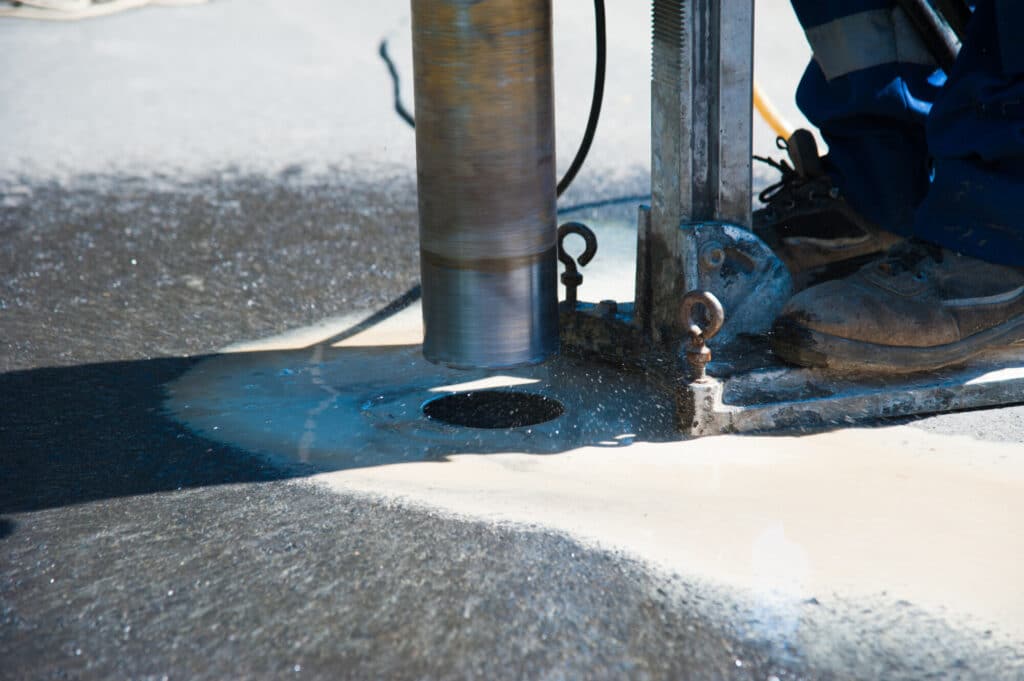Projections show that the global diamond core drilling market will reach a value of $1.8 billion by 2031.
Construction projects can involve a vast range of techniques and processes. Among those, one that can be incredibly useful is core drilling.
By core drilling concrete and other materials, you can achieve specific goals that most other techniques simply aren’t suitable for.
So what is core drilling, and why is it useful? Keep reading to find out.
What Is Core Drilling?
Core drilling is a process that’s used to create holes in floors, walls, or other structures. It’s done using a hollow cylindrical core bit, tipped with diamond segments. The main core drill components include a motor, a stand, and diamond drill bits.
Various other concrete cutting tools are available, but a core drill can extract a sample while drilling, which other equipment can’t. This is due to the hollow center, which allows the user to collect a core sample. This sample will match the shape of the drill bit.
Core drilling is often used to make precise holes in concrete but can also be used for other materials such as brick, block, or asphalt. The most suitable core bit will depend on the material you’re drilling. You have to match the diamond core bit to the material – you shouldn’t use a diamond bit that was made for concrete in asphalt!
The drills themselves can vary significantly in size, power, and other features. The exact drill you should use will depend on the diameter and depth of the required hole. Larger diameter holes require core drills that are capable of spinning the diamond bits at lower RPM’s. Holes that are greater than 26” in diameter require the use of hydraulic core drills.
How Does Core Drilling Work?
Most core drilling projects start with a GPR (ground penetrating radar) scan to assess the structural integrity of the area that’s to be drilled. This process is non-destructive and can help confirm that it’s safe to drill.
The concrete core-drilling machine has a threaded arbor where the diamond bit is mounted. The machine is then secured to the surface of the material, usually with a wedge anchor or drop in anchor, and the diamond bit is drilled into the surface.
When the desired depth is reached, the diamond bit is removed from the hole. The “core” will typically remain inside the diamond bit and can be saved for compression testing or additional analysis if desired.
Occasionally, however, the core will fall below on an elevated slab or bridge deck or pier. This core is also known as a “slug.” The resulting hole can then be used for the project as needed.
Why Use Core Drilling?
There are various other techniques for making holes in concrete that you can use, but core drilling is usually the best choice. Larger diameter holes and deeper holes usually cannot be achieved with carbide rotary hammers or rock drills.
If there is any reinforcement in the concrete (rebar, wire mesh, etc.) then carbide bits cannot be used. They can’t cut through the metal reinforcement. In addition, these methods can damage the surrounding concrete. Core drilling is the logical option.
You can take a core sample and analyze it for various reasons. Some of the characteristics that can be assessed ate:
- Material quality
- Material strength
- Material capacity
- Weight it can hold
- Current deterioration of the material
Engineers can use the information gathered as it’s representative of the rest of the material at the site. On top of this, core drilling through concrete is ideal for creating holes that can be used to transport materials through.
What Projects Need Core Drilling?
Any project that includes concrete can make use of core drilling. High rise building projects, office or store fit outs, school construction projects, wastewater treatment plants, and bridge projects can all require core drilling.
Plumbers and electricians need to core holes to install pipes or electrical risers from floor to floor or through walls. HVAC contractors need holes for air conditioning lines. Bridge contractors need holes for installing pilings, drilling out bridge bearing, or for lifting slabs, parapets, etc.
What Are the Benefits of Concrete Core Drilling?
While there are many other ways to cut holes and different ways to take samples, core drilling in concrete is the best in many situations as it does both together. It also provides various benefits that make it superior to other techniques.
Accuracy
Core drilling is an exact technique. The core drill and stand is lined up with the desired hole location anchored in place, level or plumb.
Many workers prefer diamond tools, and core drilling in concrete uses diamond-tipped drill bits. They can penetrate easily and accurately through all kinds of materials while creating minimal waste.
Versatility
Other drilling techniques don’t use diamond-tipped drill bits. This means there are often materials that they can’t cut through.
With diamond drill bits, core drilling is suitable for getting through even the hardest types of rock. The sizes also vary significantly, making it ideal for a wide range of projects.
Speed
Core drills are incredibly quick. They can get through any material faster than most other methods. Saving time in a construction project is always ideal.
Noise-Free
Many of the processes used in construction projects create a lot of noise. Core drilling is one of the few that is very quiet. This is ideal for workers as there’s no risk of hearing damage, and it won’t cause any disruption to other people in the nearby area.
Cost-Effective
Saving on costs is always the goal, and despite what people often think, core drilling is a very cost-effective process. The diamond-tipped drill bits are incredibly durable so they can put up with a lot of wear and tear. This helps save on the overall cost of the project.
Core Drilling Concrete on the East Coast
Core drilling is one of the most effective cutting techniques available. It’s fast, accurate, noise-free, and very cost-effective. You can use core drilling for concrete, brick, block, or asphalt and more.
JP Hogan is a professional concrete coring and sawing business based in Staten Island, NY. We provide a range of concrete services throughout the east coast, so if you need core drilling services, or anything else, we’ve got you covered. Visit our website and get a free estimate today.



